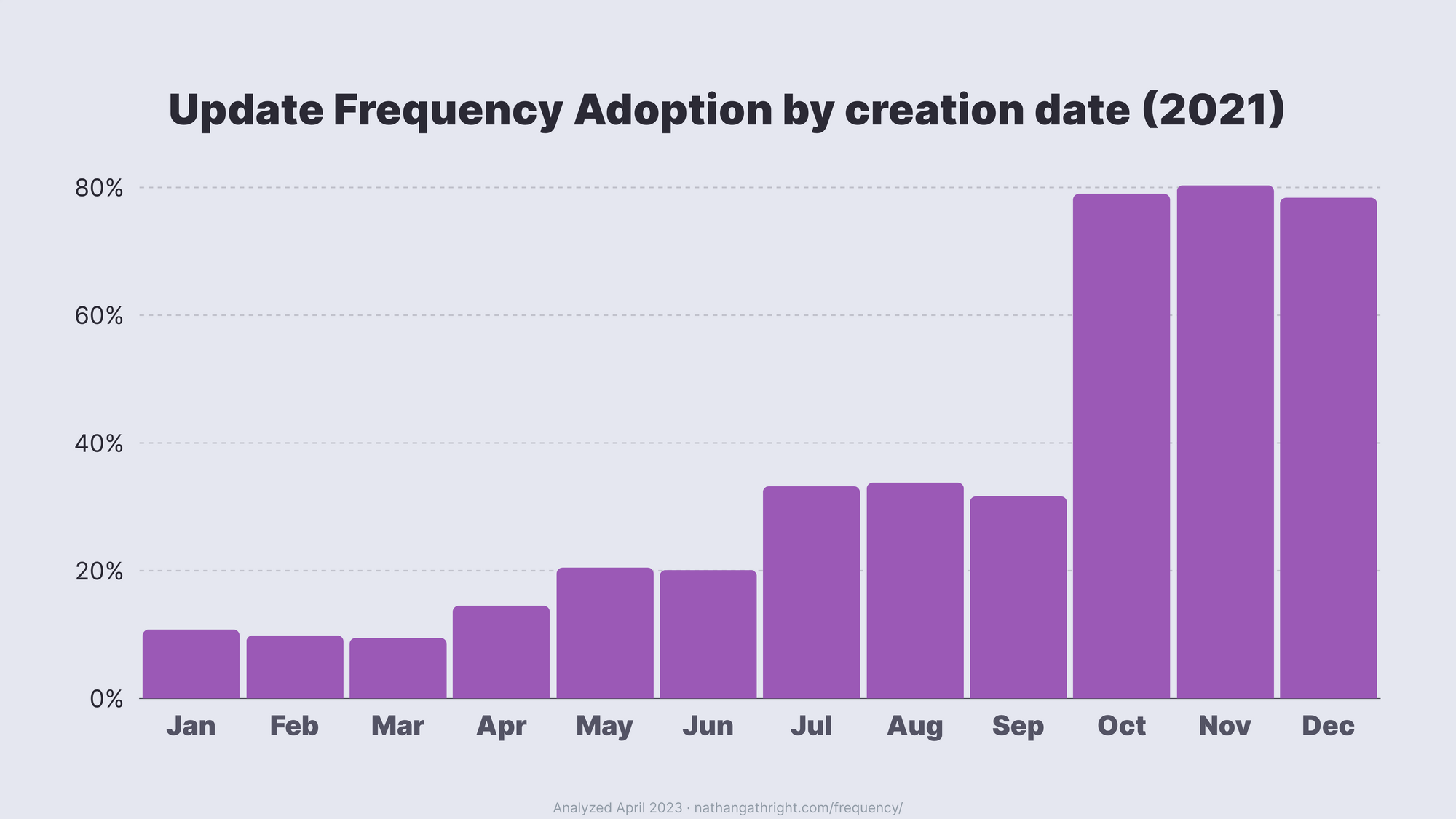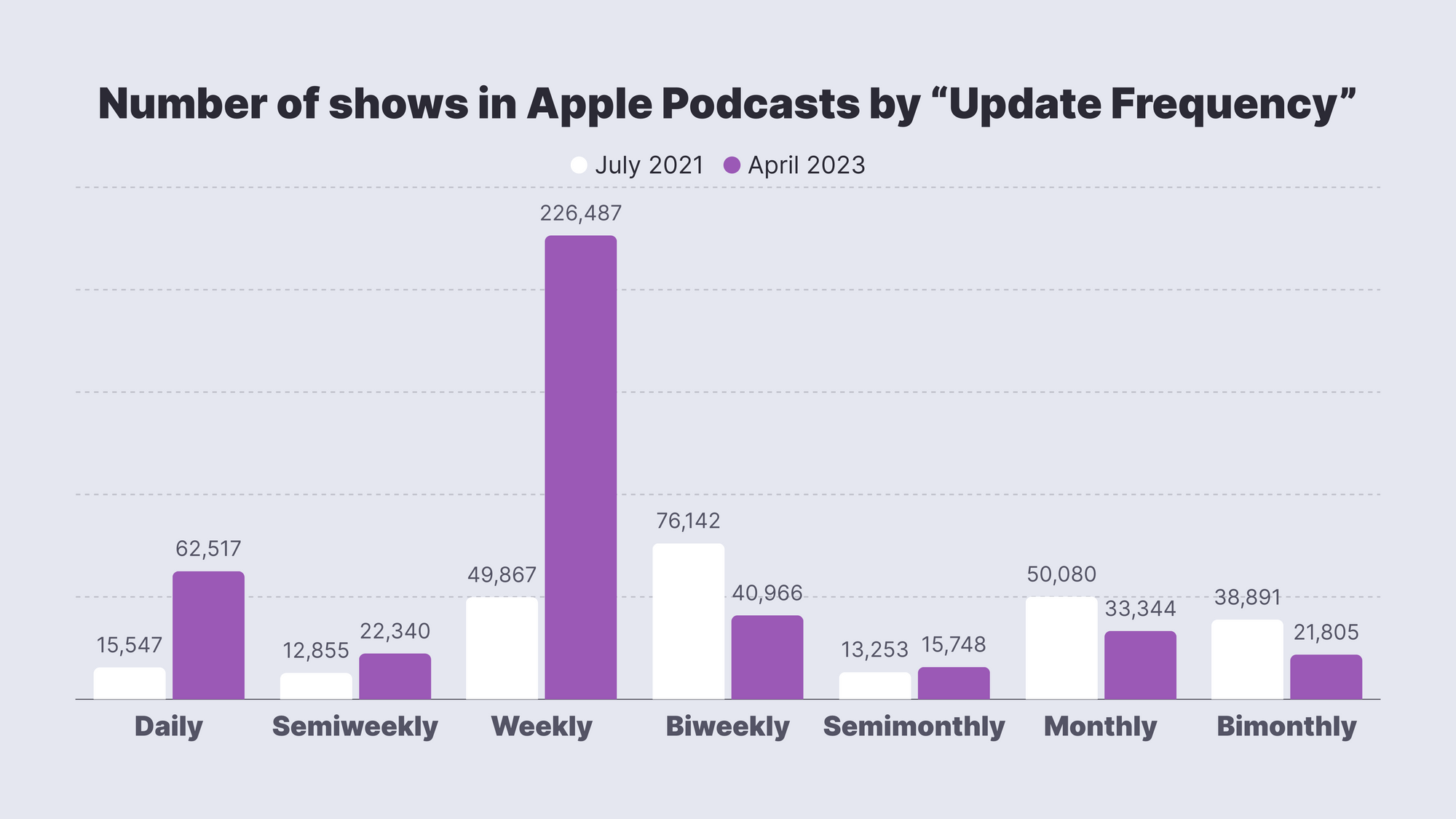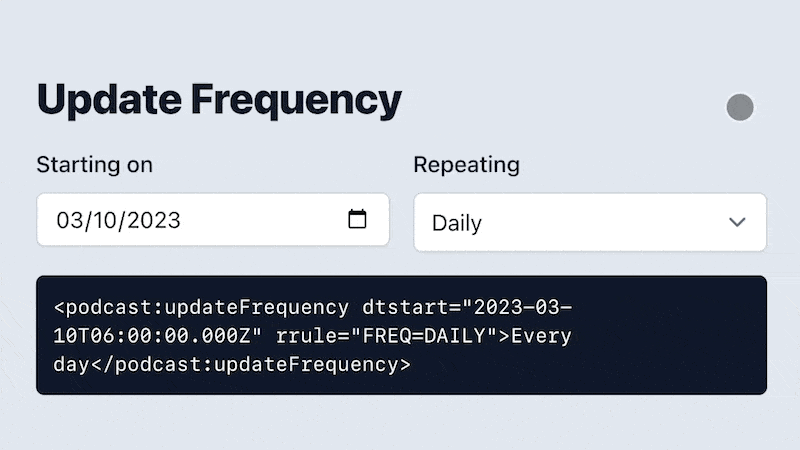Examining Update Frequency: Two Years Later

In April 2021, Apple Podcasts let podcasters specify an Update Frequency to help listeners know how often podcasts plan to update their show with new episodes. Two years later, I wanted to revisit that analysis and propose a way to bring this feature to all podcast apps.
Adoption
In July 2021, when Dan Misener sampled 1,896,631 podcasts, he estimated that 256,635 or 14% of all shows in Apple Podcasts had an Update Frequency value set to one of the seven available options (daily, weekly, semiweekly, biweekly, monthly, semimonthly, bimonthly).
When I ran the same analysis in April 2023, I sampled 2,200,746 shows and found 423,066 had set an update frequency, meaning the overall adoption rate only increased to an underwhelming 19%. (Not quite worth publishing a new article.) However, if we break down the shows by date created, a different story emerges:

For shows created after September 24, 2021, 80% have set an update frequency, which is a massive improvement. What could have spurred so much interest? Around the release of iOS 15, it turns out that Apple Podcasts Connect made update frequency a required field, which actually makes it impressive that the adoption is anything less than 100%.
Selection
Misener observed that “biweekly” was the most popular selection. Of shows with an Update Frequency, nearly 30% picked it. Comparing then and now, biweekly has fallen to the third most popular selection (10%), after weekly (54%) and daily (15%).

Intention vs Reality
A key observation from Misener noted:
Apple’s update frequency setting does not reflect how often episodes of a podcast are actually released. It simply signals the podcaster’s intended release cadence.
So let’s dig into that! I scraped their feed for published dates for every show with an Update Frequency. (Since these values can be manipulated, this is not perfectly reliable, but it should still serve our purpose.) Looking only at episodes released in the last three years, I found:

If podcasters are living up to their intentions, we now have a better sense of what they think “biweekly” or “bimonthly” means: roughly every two intervals. However, “semiweekly” shows have a longer average frequency than weekly shows, which could be attributed to a wider spread of opinions on the definition of “semi” or chalked up to the difficulties of publishing at a higher frequency.
Moving to an open standard
Over two and a half years before Apple added Update Frequency to their app, Marco Arment added the feature to Overcast. In his review of Overcast 5, Federico Viticci wrote:
Episode frequency is the kind of feature that makes complete sense once you think about it – wouldn’t it be nice if your podcast client gave you an idea of when to expect a new episode of a show? … as a listener, I find the extra information useful, particularly when considering subscribing to a new show.
Analyzing past episodes’ release dates can be valuable, but those algorithms can’t differentiate between a one-off outlier or an emerging pattern. As shown in the chart above, podcasters clearly have difficulty keeping to their intended schedule, and that’s precisely when these algorithms need more information to work with. Without additional information in the feed, these apps can’t predict the intended release schedule, especially for new podcasts with only a trailer or serialized podcasts nearing the end of a season.
Listeners in all podcast apps should be able to evaluate a show based on the podcaster’s intended frequency. I’ve written a proposal for the podcast namespace for hosts and apps to enable podcasters to communicate their intended release schedule. Podcasters could easily express one of those seven options (daily, weekly, semiweekly, biweekly, monthly, semimonthly, bimonthly). But it would also give them a free-form way to express more nuanced schedules like “Every Wednesday and Friday” or “Every Monday until Dec 31, 2023”.
While apps could show listeners the free-form text unmodified, the tag would also provide the update frequency as structured data they could use to display when the next episode is expected. (Note: this shouldn’t be used for feed crawling. For that, we recommend apps support podping.) I built a sample user interface to show how a host might implement this in their own dashboards:

Looking ahead
While the adoption of Update Frequency in Apple Podcasts has grown, it’s only available on one platform. If enough developers support this new tag, podcasters across all platforms could easily communicate their intended release schedule, giving listeners a more accurate expectation of when new episodes will be available.
Follow Along
Get the latest posts delivered right to your inbox